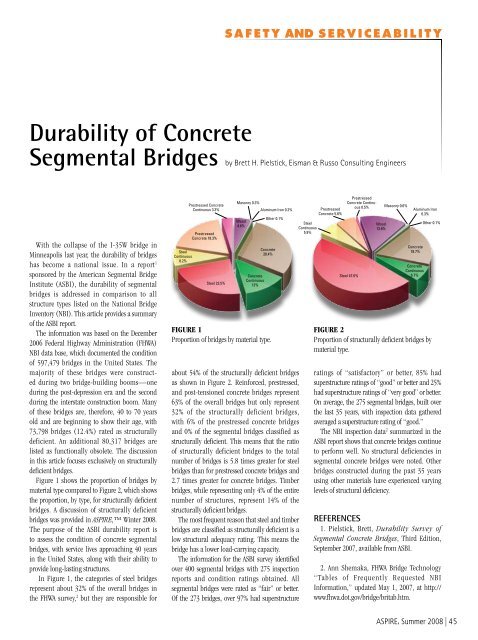ASPIRE Summer 08 - Aspire - The Concrete Bridge Magazine
ASPIRE Summer 08 - Aspire - The Concrete Bridge Magazine
ASPIRE Summer 08 - Aspire - The Concrete Bridge Magazine
- No tags were found...
You also want an ePaper? Increase the reach of your titles
YUMPU automatically turns print PDFs into web optimized ePapers that Google loves.
S A F E T Y AND S E R V I C E A B I L I T YDurability of <strong>Concrete</strong>Segmental <strong>Bridge</strong>s by Brett H. Pielstick, Eisman & Russo Consulting EngineersWith the collapse of the I-35W bridge inMinneapolis last year, the durability of bridgeshas become a national issue. In a report 1sponsored by the American Segmental <strong>Bridge</strong>Institute (ASBI), the durability of segmentalbridges is addressed in comparison to allstructure types listed on the National <strong>Bridge</strong>Inventory (NBI). This article provides a summaryof the ASBI report.<strong>The</strong> information was based on the December2006 Federal Highway Administration (FHWA)NBI data base, which docu mented the conditionof 597,479 bridges in the United States. <strong>The</strong>majority of these bridges were constructedduring two bridge-building booms—oneduring the post-depression era and the secondduring the interstate construction boom. Manyof these bridges are, therefore, 40 to 70 yearsold and are begin ning to show their age, with73,798 bridges (12.4%) rated as structurallydeficient. An additional 80,317 bridges arelisted as functionally obsolete. <strong>The</strong> discussionin this article focuses exclusively on structurallydeficient bridges.Figure 1 shows the proportion of bridges bymaterial type compared to Figure 2, which showsthe proportion, by type, for structurally deficientbridges. A discussion of structurally deficientbridges was provided in <strong>ASPIRE</strong>, Winter 20<strong>08</strong>.<strong>The</strong> pur pose of the ASBI durability report isto assess the condition of concrete segmentalbridges, with service lives approaching 40 yearsin the United States, along with their ability toprovide long-lasting structures.In Figure 1, the categories of steel bridgesrepresent about 32% of the overall bridges inthe FHWA survey, 2 but they are responsible forSteelContinuous8.2%Prestressed <strong>Concrete</strong>Continuous 3.3%Prestressed<strong>Concrete</strong> 18.3%Steel 23.5%Masonry 0.3%Wood4.6%<strong>Concrete</strong>Continuous13%<strong>Concrete</strong>28.4%FIGURE 1Proportion of bridges by material type.Aluminum Iron 0.2%Other 0.1%about 54% of the structurally deficient bridgesas shown in Figure 2. Reinforced, prestressed,and post-tensioned concrete bridges represent63% of the overall bridges but only represent32% of the structurally deficient bridges,with 6% of the prestressed con crete bridgesand 0% of the segmental bridges classified asstructurally deficient. This means that the ratioof structurally deficient bridges to the totalnumber of bridges is 5.8 times greater for steelbridges than for prestressed concrete bridges and2.7 times greater for concrete bridges. Timberbridges, while repre senting only 4% of the entirenumber of structures, represent 14% of thestructurally deficient bridges.<strong>The</strong> most frequent reason that steel and timberbridges are clas sified as structurally deficient is alow structural adequacy rating. This means thebridge has a lower load-carrying capacity.<strong>The</strong> information for the ASBI survey identifiedover 400 segmental bridges with 275 inspectionreports and condition ratings obtained. Allsegmental bridges were rated as “fair” or better.Of the 273 bridges, over 97% had superstructureSteelContinuous5.9%Prestressed<strong>Concrete</strong> 5.8%Prestressed<strong>Concrete</strong> Continuous0.5%Steel 47.6%Wood13.8%Masonry 0.6%Aluminum Iron0.3%<strong>Concrete</strong>18.7%<strong>Concrete</strong>Continuous6.7%Other 0.1%FIGURE 2Proportion of structurally deficient bridges bymaterial type.ratings of “satisfactory” or better, 85% hadsuperstructure ratings of “good” or better and 25%had superstructure ratings of “very good” or better.On average, the 275 segmental bridges, built overthe last 35 years, with inspection data gatheredaveraged a superstructure rating of “good.”<strong>The</strong> NBI inspec tion data 2 summarized in theASBI report shows that concrete bridges continueto perform well. No structural deficiencies insegmental concrete bridges were noted. Otherbridges constructed during the past 35 yearsusing other materials have expe rienced varyinglevels of structural deficiency.REFERENCES1. Pielstick, Brett, Durability Survey ofSegmental <strong>Concrete</strong> <strong>Bridge</strong>s, Third Edition,September 2007, available from ASBI.2. Ann Shemaka, FHWA <strong>Bridge</strong> Technology“Tables of Frequently Requested NBIInformation,” updated May 1, 2007, at http://www.fhwa.dot.gov/bridge/britab.htm.<strong>ASPIRE</strong>, <strong>Summer</strong> 20<strong>08</strong> | 45
















